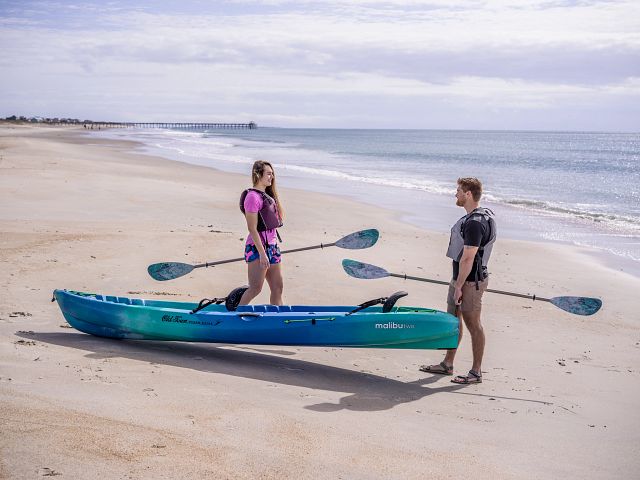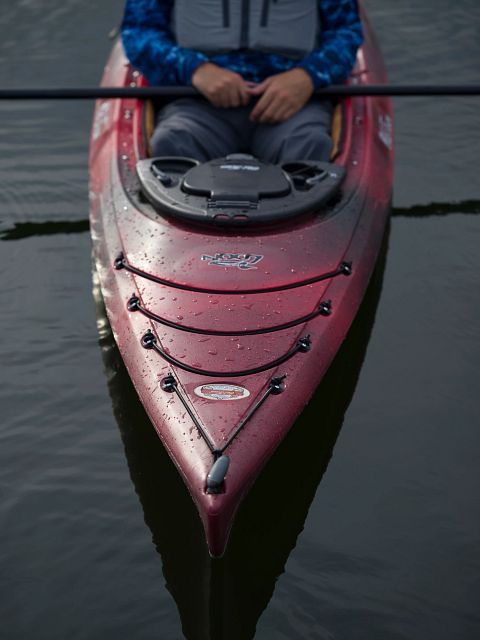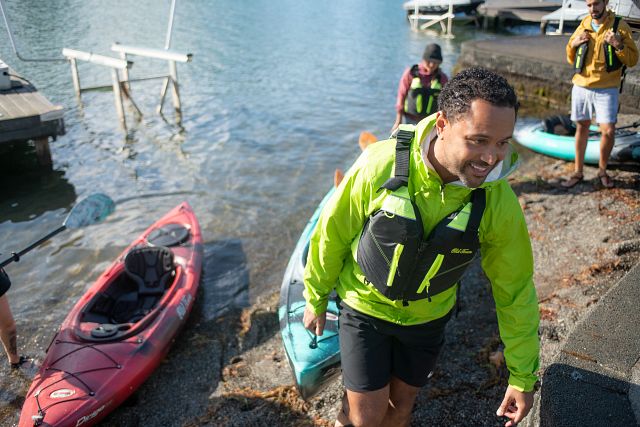Sit-In vs Sit-On-Top Kayaks - Which to Choose?
There are a lot of kayak options out there, but one of the biggest decisions you can make is whether you want a sit-in or a sit-on-top kayak. There are pros and cons for each type, for different kinds of kayakers. The climate you’re paddling in and the activities you have planned will have a big effect on your choice of sit-in vs sit-on-top kayak.

Sit-On-Top Kayaks
Sit-on-top kayaks (also called “open kayaks” or “top sit kayaks”) are built without a cockpit. Instead of sitting down into the boat, the seat (and the kayaker) are out in the open air. These kayaks offer advantages to pedallers, anglers, and more.
Advantages of a Sit-On-Top Kayak
With no cockpit to get in and out of, a sit-on-top kayak is more accessible. It’s easier for people with mobility issues to enter and exit. It can accommodate a larger array of body sizes, including people with wider frames or longer legs. Sit-on-top kayaking is easier for almost everyone to enjoy.
There are other advantages, too. If your kayak overturns, it’s much easier to make a quick exit if there’s no cockpit to squeeze out of. It’s also easier to hop in and out of for put-in and take-out.
Open kayaks have scupper holes where water can drain out, making them more self-bailing than a sit-in kayak. And because their center of gravity is higher, sit-on kayaks tend to be wider and more stable.
Because they’re more open, sit-on-top kayaks are great for fishing, as well. Not being confined to a cockpit offers a greater range of motion for casting. It also makes it easier to install a pedal drive, which comes with plenty of advantages of its own. Finally, the large, flatter surface of a sit-on-top kayak gives it extra room for storage space. There’s plenty of room for carrying gear and anything else you might need with you on the water.

Disadvantages of a Sit-On-Top Kayak
Sit-on-top kayaks aren’t right for every kayaker or every situation. There are a few drawbacks. Bear in mind that a pro for one kayaker might be a con for another. It’s all a question of what you need your kayak for, and what features are important to you.
One slight disadvantage is that without a cockpit and the protective skirt that surrounds it, you’re more likely to get wet as you paddle or pedal through the water.
Also, the same width that gives sit-on kayaks their stability also makes them a little slower. The trade-off between stability and speed is always an important conversation to have when choosing a kayak, and it comes down to personal preference.
Sit-In Kayaks
You may hear a sit-in kayak called a “sit inside kayak,” “closed kayak,” or “enclosed kayak.” The paddler sits down inside an enclosed space, with their legs stretched out down the length of the boat.
This is a more traditional style of kayak, dating back at least 4,000 years to the northernmost regions of North America. Indigenous groups like the Inuit, Aleut, and Yu’pik people made their kayaks out of stitched animal skins, stretched over a frame made of wood or whalebone.

Advantages of a Sit-In Kayak
Sit-in kayaks have advantages of their own. The cockpit ensures closer contact between your thighs and hips and the boat. This makes it easier to use your body to control the boat’s movement. Many sit-in kayaks have knee braces as well, for the same reason. And of course, an enclosed cockpit keeps you warmer, and if you attach a skirt to the cockpit it can keep you drier, as well.
Lastly, the narrower design of most sit-in kayaks makes them faster, which can be important if you have a lot of distance to cover.
Disadvantages of a Sit-In Kayak
Again, a pro for one kayaker can be a con for another. But there are some things to bear in mind when considering a sit-in kayak. If the boat tips over, it’s harder to exit. It can also be harder to right the boat when filling with water.
In addition, these boats are less stable than their sit-on-top cousins. People with larger frames or mobility issues may find it harder to get into a cockpit than to just sit on top of a boat.
Finally, it’s a lot harder to re-enter the kayak from the water if you bail out.

Special Use Cases
Some kayaks are purpose-built for one task or another. There are cases where your choice of sit-on-top vs. sit-inside kayak is going to depend on what you want to do with it. For anglers and touring enthusiasts in particular, your choice is going to come down to your favorite activity.
Fishing
Sit-on-top kayaks excel as fishing kayaks. They’re more open, allowing you a wider range of motion. They have more room to store gear and other necessities while on the water. Their enhanced stability makes them a great platform for fighting fish. They have more room to store your big haul, and space for gear storage, rod holders, and more. All that space also means that it’s easier to put in a pedal drive with a sit-on-top kayak. Most fishing kayaks will be sit-on-tops.
Touring
For touring, sit-in kayaks tend to be preferable. They’re longer and built for speed, and the cockpit gives you the extra control you need to maneuver in the face of choppy waters. Greater contact with your hips, knees, and rear lets you use your body to help control the boat. And keeping your body enclosed inside a cockpit means you stay warmer on a long trek through cold waters.
Recreation
When it comes to recreational paddling, it’s more of an individual choice. It has to do with your body type, the climate where you’ll be paddling, and the experience you want. However, the dimensions of each kayak are unique, and this rule may not play out for every single pair of kayaks you’re looking at.
Sit-on-top kayaks are better for taller folks, or people with larger frames. They’re also great for warmer waters, where you don’t mind getting a little wet. And if you plan on hopping out of your boat for a little swimming or diving, you’re going to have a much easier time climbing back into a top-sitting kayak.
Sit-in kayaks are going to be better for those who value speed and control. They’re also better for colder climates. If you’re going to be weathering fast waters and don’t plan on leaving your boat, a sit-in kayak may be your best bet.

Making a Decision
In the end, it all comes down to your priorities. Sit-ins are great for touring, cold water, and anyone who needs the speed and control of the traditional kayak experience.
But for beginners, anglers, divers, or anyone who might hop out of their boat for a spell to enjoy the water, you can’t beat a sit-on-top kayak.
The good news is that there’s not a bad choice here. As long as you have a boat that makes you feel comfortable and gets you time on the water, you’ve made the right choice. Find the right kayak that works for you, and get out there!






